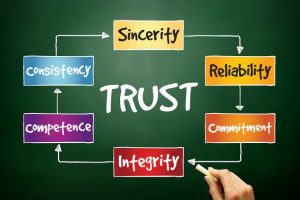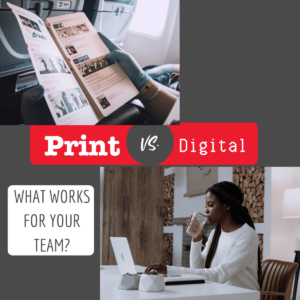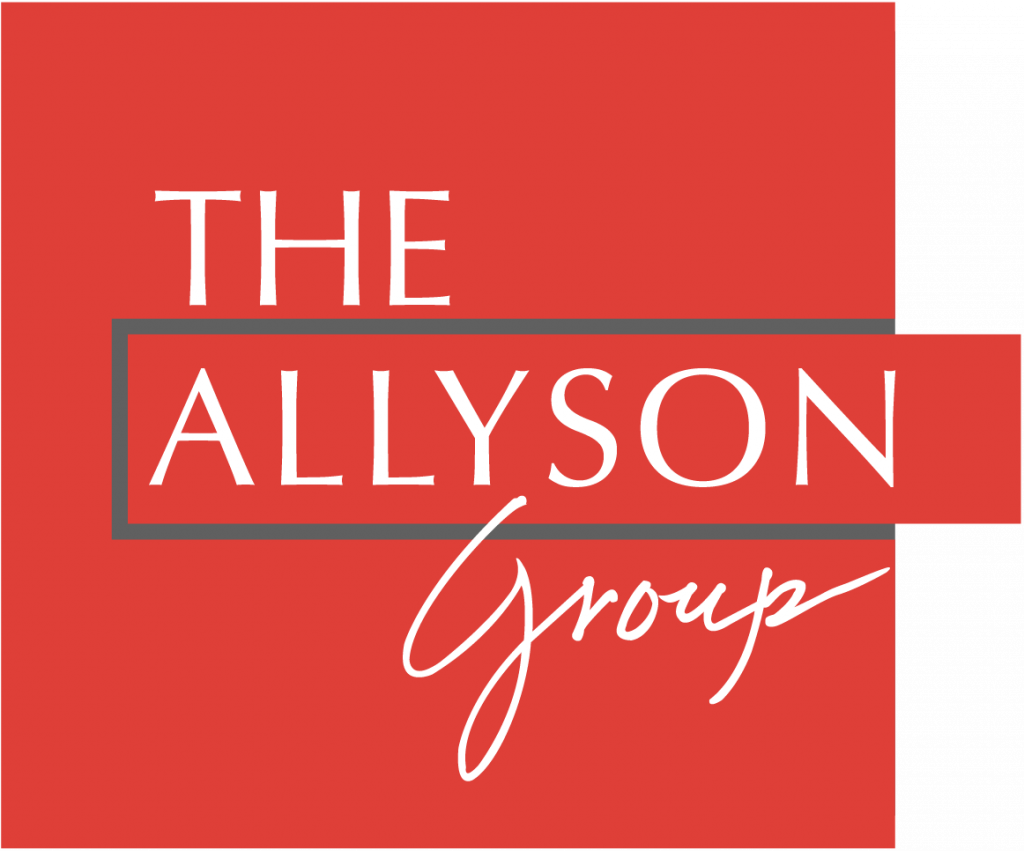An online search for the word “brand,” by itself, will bring up a seemingly infinite number of different answers. The term means many different things.
But in the business context, your “brand” is your company’s public identity. Where people get confused is that your brand is not what you think about your company. Rather, it is what others think. You can craft compelling mission statements all day long. But you create your real brand day in and day out. You do this with your actions, the quality of your relationships, and the integrity of your business practices.
Amazon’s Jeff Bezos apparently described brand as “what others say about you when you’re not in the room.” That’s your real brand.
As a company, you express your brand in many ways:
-
- a logo, tagline, brand colors, fonts – your visual brand
- customer service – how customers experience your business
- workplace culture– what it’s like to be your employee
- business identity – what it’s like to work with you – for example, as a supplier or another business partner
Let’s consider each element of your brand identity separately:
Your Visual Brand
One of the most common points of confusion is a belief that a company’s logo and visual symbols are their brands. Wrong. In fact, these are only the symbols of a brand.
With these visual symbols, companies try to be memorable. The symbols are meant to “brand” the company in the minds of consumers. This is the origin of the term. Over time, the term has taken on a much broader meaning.
When you get to the point where large numbers of people know your company by its symbols alone, you have built a successful brand. Think McDonald’s golden arches, the distinctive Coca Cola lettering, or the Nike swoosh.
That high level of visual brand recognition is a form of equity.

Book your free consultation today!
Who You Are for Customers
For customers, your brand is created by all their interactions with you, beginning with the very first impression.
Customers seek out your product or service to fulfill a need or solve a problem. The easier you make it to meet that need or solve that problem, the more favor they will lavish on your brand.
If you successfully meet their expectations each time they come to you, they will reward you with repeat business, referrals, reviews, and brand loyalty.
Without customers, you have no business. Meeting or exceeding customer expectations is the fundamental building block of brand success.
Workplace Culture as an Element of Your Brand
The environment inside your company is another element of your brand. What is it like to work for you?
If the people who work at your company are content, they will communicate that to others. If they are not, they will communicate this too. All of it becomes part of your brand.
Remember, your brand is not the company you created in your mind; it is the company you’ve created in the real world.
Building a strong brand requires the active participation of employees. Companies who know this invest in their employees. They are intentional about creating a workplace culture that supports personal and professional growth for employees.
A strong workplace culture helps attract and retain good people. This both reduces the costs of turnover and can turn employees into powerful brand ambassadors. Brand ambassadors are people who actively promote your brand.
Business and Community Relationships that Help Define Your Brand
How your company interacts with other groups also influences the value of your brand.
Are you known as an honest and fair business partner? Do you pay suppliers and vendors on time?
Do people know your business for anything other than your product or service? For example, are you active within your local business community? Does you support charities that your customers, employees, or business associates care about?

If you can answer yes to all these questions, you are actively building up your company’s brand identity.
This is also where companies can prove their commitment to the vision and values they declared in their mission statements. Walking the talk, it’s called; and it is a powerful brand builder.
Identifying Opportunities for Your Brand
Growing Your Communications Capacity
Great communication is a crucial element in building a successful brand. “Great” communication for the purposes of this article means clear – and useful. Growing your communications capacity will help with all the audiences you work with. You’ll need clear:
- employee communications to help your people deliver on your brand promise to customers and achieve career success
- communication with customers to support the buying process – to help consumers understand, choose, buy, and exchange products
- communication with all groups to help shape and manage expectations, create transparency, and establish trust
Virtually ALL of a company’s official communication is brand communication.
 Some of the best opportunities for companies to communicate their brand are not sexy – but they are continuously available:
Some of the best opportunities for companies to communicate their brand are not sexy – but they are continuously available:
-
- hiring materials
- employee handbook
- product catalogs
- company brochure
- advertising
- marketing materials
- website
- blog
- social media
- white papers
There are lots of ways to weave in storytelling that will leave an impression and help people remember you.
Brand Storytelling
People love stories. Assuming that your business meets a need or solves a problem for people, you should have a good brand story. Tell it.
Corporate storytelling is an art – but there is a lot of science behind it. Companies that weave stories into their communication find it much easier to make themselves stand out. This is because your company story is the one thing you can be sure is truly unique.
Some of the brands that excel at corporate storytelling are the ones we all know best. Brands like Levi’s jeans, Warby Parker eyeglasses, and Benjamin Moore paint use storytelling to tap into our emotions. It helps them sell because that’s the side of the brain – our emotions – with which we make most buying decisions.

Who consumes your product? Computer scientists or painters, civil engineers, or moms? Although each customer group requires a different type of communication, almost all groups will understand your product better if you tell them about it with stories.
Brand Ambassadors: Partners in Your Brand’s Success
When you get other people buying into and helping tell your story, you have created brand ambassadors.
Companies that make it a goal to inspire employees, customers, and business partners cultivate in these groups tremendous opportunities for brand building.
Anyone who loves your product or service – or respects your company as a community citizen – can be turned into a brand ambassador. You supply the words (key messages), images, opportunities, and incentives for them to speak on your behalf.
Third-party endorsements are much more convincing than anything you say about yourself. That’s why reviews, testimonials, and endorsements are so important. Employees speaking at professional conferences or appearing in ads are relatively inexpensive ways to accomplish this.
Who could be an ambassador for your brand? Sit down and make a list – and a plan to get them going.
Avoiding Risks to Your Brand
A Poor First Impression
Many people will first experience you online – people who are searching for the kind of solutions you provide. An unprofessional website will hurt your brand.
At a minimum, every company needs a professional website that offers value to its customer and represents the company well.
A social media program may be optional (although not everyone agrees on that). But if you’re going to have one, make sure it also meets the highest professional standards you can manage. What’s required? Consistency, relevancy, and usefulness are essential.
Some companies think they’ve got to be present on all social media platforms. However, companies that are highly protective of their brand use only the social media they can use well. Using social media poorly (inconsistent, irrelevant, useless) will not help build an audience and bring in customers, but it can make your company look bad.
Each platform has unique characteristics, and it’s possible to succeed using just one (or two). The choice should be based on where your kinds of customers show up. And how much time – or budget – you can put into creating consistent, relevant, and highly useful content.
While most businesses want to have some social media presence today, it is better to be absent than to look bad. You can’t open a Facebook company page and then just let it sit there. Better not to have it at all.
What makes you look bad? Things like:
- Infrequent posting
- Outdated or wrong information
- Typos, misspellings, or bad grammar
- Bad links and error messages
- Low-quality photos
- Irrelevant or inappropriate photos
- Blog: non-strategic; unplanned random topics with no clear purpose
DIYing – Doing it All Yourself
Trying to do everything yourself presents another type of business risk. It’s easy for business owners to get help from professional copywriters and content creators to avoid or fix these kinds of mistakes.
There are lots of good reasons for hiring professionals to handle some of the communications workloads for your brand. Objectivity, outside-the-box ideas, and multiple voices behind the writing are three very good reasons.
The cost for professional copywriters to audit and upgrade the content on business websites will be far less than the costs of business you lose with a poor first impression.
As for social media, outsourcing the function (or assigning the job to someone else inside your company) will transfer the accountability, and keep your postings on schedule.
Most professionals will also be experts at using the measurement tools provided by social media (analytics) and can provide regular reports on what content people click on most and which social media platforms generate most of your traffic. Using these tools gives you the information to shape and refine your tactics over time.
Most of all, hiring professionals frees you up to focus on what you’re best at – running your business and building your brand.
Ignoring Brand Consistency

Brand consistency is vitally important if the goal is to achieve brand recognition. Lack of it is a huge business risk. If you get too creative with messaging – always changing – or too free with the look and feel of your brand symbols – how will the public always know it’s you?
The very concept of “branding” is based on consistency. But ensuring consistency is something you have to be intentional about and must enforce.
Companies trademark their symbols and fight in court to protect them if another company tries to appropriate or imitate them. But to help people who have permission to use your symbols, it’s a good idea to publish a brand style guide.
A style guide is a formal document that tells everyone how the visual elements of your brand must be treated. For a corporation, it may be a manual or handbook. For a small business, it may be a single page. But having one saves a lot of headaches and helps keep everyone on the same page. It also demonstrates seriousness about protecting your brand.
Send it to all your writers, content creators, graphic designers, and sales and marketing teams. If multiple writers are creating content for a single brand, they will rely heavily on the organization’s style guide.
Protecting Your Brand in the Age of the Internet
The internet has been a game-changer when it comes to organizational communication.
On the one hand, it presents massive opportunities to reach worldwide markets. Today, you can run a marketing and communication program that efficiently services all your audiences without spending a fortune on advertising.
But new risks come along with that.
- For one thing, businesses pay a price for poor online communication. If a company looks second-rate on the web, consumers decide that their product is too. Badly written copy, dense text, and grammatical errors all take away from people’s trust in your brand.
- Then there are other potential perils – like online reviews. Unhappy employees can post negative reviews on sites like Glass Door, where prospective employees can easily find them. And many good companies end up with bad customer reviews on sites like Google and Yelp. The cost of bad reviews can be high. All it takes is one or two to chase away prospects and cut into your bottom line.
- The internet also has made piracy a commonplace crime. Companies, as they grow, have to closely monitor the web to protect their copyrights and trademark rights. Artists, designers, and anyone creating copyrighted material must be vigilant in protecting their visual (mostly) assets from thieves.
But here’s the good news. It’s easy to take control of your brand online.
Professional Help to Manage Your Online Brand
As copywriters and content creators, our goal at The Allyson Group is to be a partner in creating your company’s success.
When we work with companies, brand conversations are at the forefront of our work. Only a complete understanding of a company’s brand gives us the information we need to:
- understand your audiences so our content can target their hopes and dreams
- communicate your company’s key messages
- create relevant, useful visual content
- utilize multiple writers and still maintain brand consistency
We audit your existing online properties and share the results. Then we work with you to make a content plan. Content planning takes the guesswork out of what, when, and where to put your content online. It even answers the “why.” We plan content quarterly and can assign different subject matter experts to the writing.
Our work provides the consistency, relevance, and usefulness that serves your customer and “brands” your company as reliable and trustworthy.
So, give us a call to talk through your brand challenges. We’ll be happy to help.
At The Allyson Group, we are content writers and content creators who can help you choose the kind of website you need, and the design firm that’s right for your budget. Call or email today and set up a time to talk through your project. No obligation, just a conversation.













This Post Has 2 Comments
Pingback: Why You Need a Style Guide for Your Business - The Allyson Group
Pingback: Maximize Graphic Design to Elevate Your Business | The Allyson Group